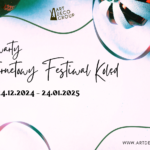[2010 r.]
Work for Choir, Percussion and Piano based the poem by Octavio Paz
Performed by Polyphony
CLOUDBURST
(translated from Spanish)
The rain…
Eyes of shallow-water,
eyes of well-water,
eyes of dreams-water,
blue suns, green whirlwinds,
bird-beaks of light pecking open,
pomegranate stars.
But tell me, burnt earth is there no water?
Only blood, only dust,
only naked footsteps on the thorns?
The rains awakens…
We must sleep with open eyes,
we must dream with our hands,
we must dream the dreams of a river seeking its course,
of the sun dreaming its worlds,
we must dream aloud,
we must sing till the song puts forth roots,
trunks, branches, birds, stars,
we must find the lost word,
and remember what the blood,
the tides, the earth, and the body say,
and return to the point of departure…
Being unemployed, watching days pass effortlessly from my living room window can drive me to insanity. Maybe I was simply bored and wanted to get out of the apartment. Whatever led me to the library resulted in discovering an article on the American composer Eric Whitacre in the pages of Gramophone Magazine. Intrigued by the article I decided to pick up a CD of his work. This review is the direct confirmation that I am, in fact, sane… but still unemployed none the less.
First off, I am no poet. Poetry can escape me like a difficult math equation. Whitacre himself has written that Cloudburst ‚is a ceremony, a celebration of the unleashed kinetic energy of all things.’ I have written the translated version of the poem above, from the liner notes, to use as a guild to point out moments that are worthy of note. This piece is performed in Spanish, the poem’s original language.
Given the title alone, certain expectations can come to mind as to how this piece may be presented. Can anyone say impressionism? But thankfully Whitacre’s personal style is accessibly contemporary constructing the voicing in beautiful dissonant passages. The beginning unstable atmospheric impression is created by layering short repeating phrases starting in the higher register and continues down the line until a swirling mash of clashing words reaches its final suspended chord.
Noting the poem structure, Whitacre composes each section as its own identity without much repetition. In the section that states “we must”, Whitacre uses the build up of chords in what may be a way of reflecting man’s ability to execute worthy intentions or the act of doing something beyond our usual existence. The common ingredient throughout the piece is the composer’s signature style of suspension and release (note I did not say resolve). Soloist phrasing both lyrical and spoken word are incorporated within the sections and are executed tastefully with the effect of moving the piece forward. Then a slow hushing phrase is softly uttered from the choir… a brief silence.
Now so far I have said nothing of the percussion for good reason. Up to this point, which is ¾ of the piece, no percussion has been used. Their employment is one of ambience, not rhythm or melody. Hand bells and chimes intermingle with the choirs’ voices leading to a crescendoed chord. It is at this point where Whitacre decides to imitate a thunderstorm by incorporating bass drum and a large metal sheet to create thunder. Rain drops are produced by the choirs’ random snapping of fingers and clapping of hands. The piano lays down the foundation for which the choir can ascend again into more swirling atmospheric phrasing.
Once the rainstorm passage has reached its zenith, Whitacre, maybe possessed by the ghost of Debussy, gives in to convention by composing an impressionistic chord progression reminiscent of “Nocturnes Sirenes”. It’s a little out of place in a piece that leans closer to the neoclassical chord structures of Hindemith than it does the gossamer mastery of Debussy.
No matter my judgment, Whitacre can take from whatever inspirations he may please. My question is if the poem had mentioned something about severe damage or loss of life would he go the way of atonal chords in the vein of Alban Berg abandoning the contemporary style he has consistently employed? Maybe. I see the reasoning for using an impressionistic style because audience members unfamiliar with classical music will still connect water, rain, storms, and clouds to it thanks to the subconscious powers of film music and Disney. To others, like myself, we see the gimmick. Luckily this part of the piece is brief and is quickly over.
Finally the piece concludes with a few quick short glissandos by the piano and the choir quietly ends its phrasing like a storm giving way to calm but the percussion continues to play quietly representing the storm’s continuing journey in the distance.
Overall I liked this piece. The choir is top tier and performed this piece quite well. Sometimes when you listen to a choral recording you can hear one voice not quite blending in with the rest but this is not the case here. The human voice just pulls off tight chords really well especially if you have a little natural reverb! Whitacre is becoming sort of a superstar in the choral world and has been signed to the Decca label and has started his own choral group based in London. He is best known to for his virtual choir on YouTube. I look forward to hearing more of his pieces in the future which I am sure will be sooner than later.
Eric Whitacre’s Cloudburst
Reviewed by Douglas J. Dennis






